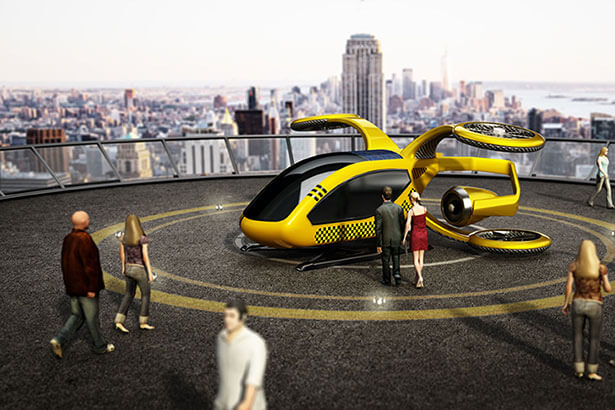
EVTOL: The Intersection of Automotive and Aerospace
Innovators have pitched flying cars as the solution to urban congestion for decades. A practical flying sedan or SUV still seems a way off though, but another class of urban air mobility (UAM) transportation is on the cusp of commercialization: the Electric Vertical Take Off and Landing (EVTOL) aircraft.
Many startups populate the EVTOL space, and some will probably not survive. Others though may thrive, and if they do so it will almost certainly be due in part to partnerships with automotive manufacturers and suppliers.
This blog introduces readers to the concepts of UAM and EVTOL aircraft. It explores trends in and the potential for EVTOL transport over the next decade and discusses how advances in electric vehicles and collaboration with automotive suppliers and manufacturers are driving this technology.
An Introduction to EVTOL Aircraft
Cities are increasingly clogged with traffic and commute times are lengthening. Bus and light rail have a role in helping people get around but journeys starting or terminating at central hubs are often slow and usually inconvenient.
An obvious solution is to fly, in a straight line, from point A to point B. However, the problem has always been the lack of an affordable, easy-to-use means of flying that needs a minimum amount of space for takeoff and landing. (This is something Uber explored in their Elevate project in 2016.)
Helicopters can take off and land vertically, but are limited by the noise they make, the difficulty of flying them safely, and their cost. Attempts at building fixed wing VTOL aircraft can at best be described as only modestly successful. These too are loud, very complex, and extremely expensive.
Electric motor technology, as used in small drones, provides a way forward. Electric motors are almost soundless and can produce high torque and power from a small volume. They are also reliable, readily integrated with sophisticated control methodologies, and relatively inexpensive to produce. What’s more, development of successful electric vehicles over the last ten years or more has both matured and advanced the technology.
EVTOL Technologies
The two main challenges industry pioneers are trying to address: what is the optimal arrangement of motors, and should they be powered by batteries or fuel cells?
Three approaches are emerging to motor configuration: drone-like multicopters with many vertically-arranged motors, lift and cruise designs, where separate rotors are used for vertical and forward motion, and vectored thrust layouts where the motors, (and possibly the wing structure,) rotate between vertical and horizontal alignment. While multicopters are more limited in payload and speed, greater simplicity and potentially lower cost seem to give these designs an advantage.
For the power or drive train, most designs use batteries, despite the obvious weight challenges they pose. Others are exploring fuel cells. These avoid the weight of batteries but need a way to store pressurized hydrogen in the airframe.
Between the energy source and the motors are the various control and power distribution systems. In addition, keeping EVTOL aircraft safe in crowded skies requires significant quantities of sensors and ancillary electronics.
The Automotive Connection
Spurred by an upstart competitor and impending internal combustion engine bans in some parts of the world, vehicle manufacturers and their suppliers have invested heavily to develop electric vehicles. In relatively short order the industry has developed both the technologies themselves and the means of producing them at scale.
Some examples, besides the batteries themselves, include:
- High voltage charging and power distribution systems
- Battery cooling
- High power density motors
- Advanced motor control algorithms based around precise VR resolvers
- Fuel cell seals and filters
- Advanced controls and algorithms
Also noteworthy, the industry is maintaining an intense focus on weight reduction or “lightweighting” to extend range and also reduce the size of battery needed. Key to this is greater use of composite materials and processes, some of which are coming across from aerospace suppliers.
EVTOL startups need these technologies and the expertise that goes with them. Rather than start from scratch, the fastest and most cost-effective route is to source them is from the companies that have spent so much on their development: the automotive manufacturers and suppliers. This is why most leaders in EVTOL have established some form of automotive partnership.
Less obviously but just as important, EVTOL developers need other technologies that were developed for automotive. For example:
- Small, precise resolvers
- Control surface actuators
- Compact antennas for GPS/GNSS and WiFi/BT
- High Speed Data (HSD) connectors
- Cooling fans
- Backlight displays
Established Partnerships
A review of published prospectuses, or a look at the list of exhibitors at leading aerospace trade shows, reveals a long list of EVTOL hopefuls. Industry press seems to view the leaders, and their automotive partners, as follows:
- Joby Aviation (which acquired Uber’s Elevate project) – partnered with Toyota
- Archer Aviation – partnering with Stellantis, (grew out of Fiat Chrysler Automobiles) for access to battery technology, and Honeywell for flight control actuation
- Eve – partnered with Porsche
- Lilium – working with automotive supplier Denso and Honeywell Aerospace
- Volocopter – working with both Geely and Daimler
- Supernal – a subsidiary of Hyundai
The Next 10 Years
EVTOL is in its infancy with many startups only able to show off preliminary design concepts. Others are more established though and have prototypes making test and demonstration flights. Forecasts suggest strong demand for UAM solutions, although realizing these will require action from legislators and certification bodies. It’s clear though, that those fastest to market will be the companies that harness and build on the EV revolution already underway in automobiles.

